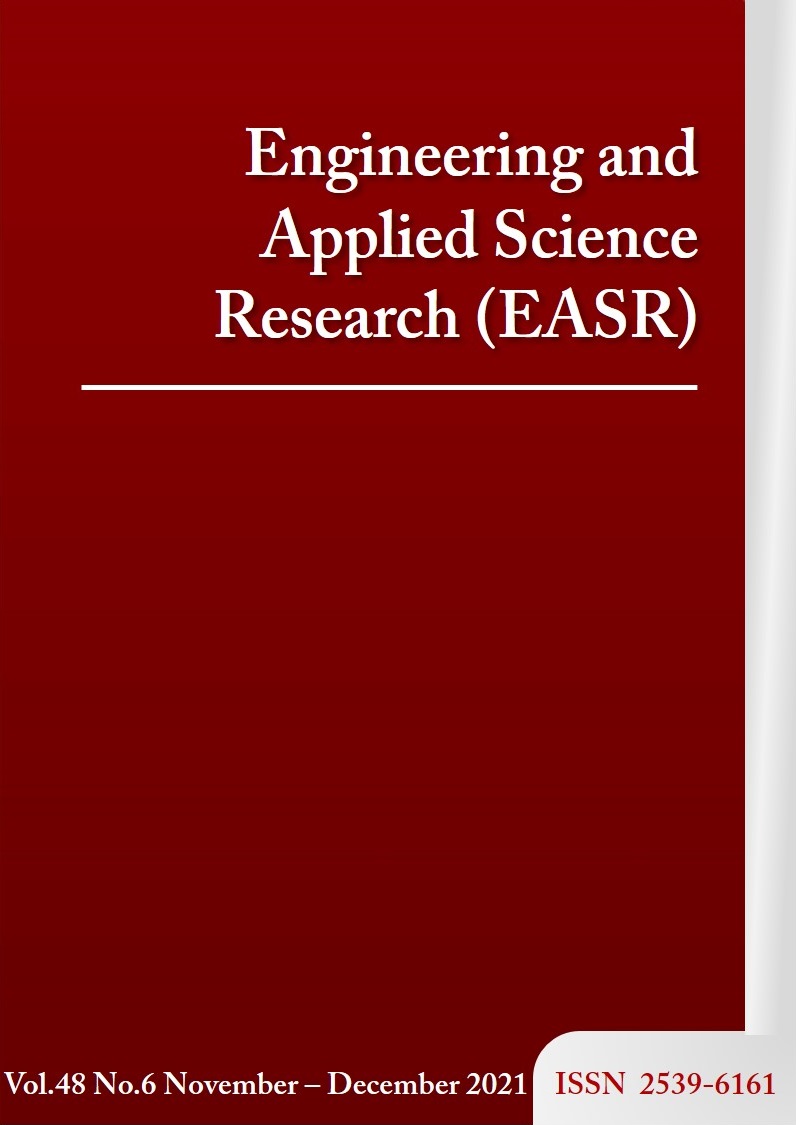Strength development and thermal conductivity of POFA lightweight geopolymer concrete incorporating FA and PC
Main Article Content
Abstract
In this study, the compressive strength, water absorption, and thermal conductivity of palm oil fuel ash (POFA) lightweight geopolymer concrete (LWGC) incorporating high-calcium fly ash (FA) and Portland cement (PC) are reported. The POFA was replaced by FA or PC at the dosages of 60% by weight of binder. The wet density of POFA-based LWGC incorporating FA and PC was designed at 1000 kg/m3, based on ASTM C796. Test results found that the incorporation of FA and PC in POFA-based LWGC could significantly improve the strength development of LWGC. The reactive Ca ions could react with SiO2 from POFA, leading to the additional formation of reaction products within the LWGC. The thermal conductivity of LWGC showed an excellent option for reducing the temperature change in the wall section during a day. It was positive effects on the building's electricity cost. A combination of POFA-based LWGC with PC met the 28-day strength and water absorption requirements as per TIS.2601-2556. Therefore, POFA-based LWGC incorporated with PC can be used as the non-load-bearing brick masonry units.
Article Details
This work is licensed under a Creative Commons Attribution-NonCommercial-NoDerivatives 4.0 International License.
References
[2] Jitchaiyaphum K, Sinsiri T, Jaturapitakkul C, Chindaprasirt P. Cellular lightweight concrete containing high-calcium fly ash and natural zeolite. Int J Miner Metall Mater. 2013;20(5):462-71.
[3] Naqi A, Jang JG. Recent progress in green cement technology utilizing low-carbon emission fuels and raw materials: a review. Sustainability. 2019;11(2):537.
[4] Hanjitsuwan S, Injorhor B, Phoo-ngernkham T, Damrongwiriyanupap N, Li LY, Sukontasukkul P, et al. Drying shrinkage, strength and microstructure of alkali-activated high-calcium fly ash using FGD-gypsum and dolomite as expansive additive. Cem Concr Compos. 2020;114:103760.
[5] Hanjitsuwan S, Phoo-ngernkham T, Damrongwiriyanupap N. Comparative study using portland cement and calcium carbide residue as a promoter in bottom ash geopolymer mortar. Construct Build Mater. 2017;133:128-34.
[6] Hanjitsuwan S, Phoo-ngernkham T, Li LY, Damrongwiriyanupap N, Chindaprasirt P. Strength development and durability of alkali-activated fly ash mortar with calcium carbide residue as additive. Construct Build Mater. 2018;162:714-23.
[7] Pangdaeng S, Phoo-ngernkham T, Sata V, Chindaprasirt P. Influence of curing conditions on properties of high calcium fly ash geopolymer containing portland cement as additive. Mater Des. 2014;53:269-74.
[8] Phoo-ngernkham T, Phiangphimai C, Intarabut D, Hanjitsuwan S, Damrongwiriyanupap N, Li LY, et al. Low cost and sustainable repair material made from alkali-activated high-calcium fly ash with calcium carbide residue. Construct Build Mater. 2020;247:118543.
[9] Davidovits J. Geopolymers - Inorganic polymeric new materials. J Therm Anal. 1991;37(8):1633-56.
[10] Li C, Sun H, Li L. A review: the comparison between alkali-activated slag (Si+Ca) and metakaolin (Si+Al) cements. Cem Concr Res. 2010;40(9):1341-9.
[11] Palomo A, Grutzeck MW, Blanco MT. Alkali-activated fly ashes: a cement for the future. Cem Concr Res. 1999;29(8):1323-9.
[12] Chindaprasirt P, Phoo-ngernkham T, Hanjitsuwan S, Horpibulsuk S, Poowancum A, Injorhor B. Effect of calcium-rich compounds on setting time and strength development of alkali-activated fly ash cured at ambient temperature. Case Stud Constr Mater. 2018:e00198.
[13] Tangchirapat W, Jaturapitakkul C, Chindaprasirt P. Use of palm oil fuel ash as a supplementary cementitious material for producing high-strength concrete. Construct Build Mater. 2009;23(7):2641-6.
[14] Tangchirapat W, Saeting T, Jaturapitakkul C, Kiattikomol K, Siripanichgorn A. Use of waste ash from palm oil industry in concrete. Waste Manage. 2007;27(1):81-8.
[15] Bashar II, Alengaram UJ, Jumaat MZ, Islam A, Santhi H, Sharmin A. Engineering properties and fracture behaviour of high volume palm oil fuel ash based fibre reinforced geopolymer concrete. Construct Build Mater. 2016;111:286-97.
[16] Ranjbar N, Mehrali M, Behnia A, Alengaram UJ, Jumaat MZ. Compressive strength and microstructural analysis of fly ash/palm oil fuel ash based geopolymer mortar. Mater Des. 2014;59:532-9.
[17] Salih MA, Farzadnia N, Abang Ali AA, Demirboga R. Effect of different curing temperatures on alkali activated palm oil fuel ash paste. Construct Build Mater. 2015;94:116-25.
[18] Phoo-ngernkham T, Sata V, Hanjitsuwan S, Ridtirud C, Hatanaka S, Chindaprasirt P. High calcium fly ash geopolymer mortar containing portland cement for use as repair material. Construct Build Mater. 2015;98:482-8.
[19] Phoo-ngernkham T, Chindaprasirt P, Sata V, Pangdaeng S, Sinsiri T. Properteis of high calcium fly ash geopolymer pastes containing portland cement as additive. Int J Miner Metall Mater. 2013;20(2):214-20.
[20] ASTM. ASTM C618-15, Standard specification for coal fly ash and raw or calcined natural pozzolan for use in concrete. West Conshohocken: ASTM International; 2015.
[21] ASTM. ASTM C796/C796M-19, Standard test method for foaming agents for use in producing cellular concrete using preformed foam. West Conshohocken: ASTM International; 2019.
[22] Hanjitsuwan S, Hunpratub S, Thongbai P, Maensiri S, Sata V, Chindaprasirt P. Effects of NaOH concentrations on physical and electrical properties of high calcium fly ash geopolymer paste. Cem Concr Compos. 2014;45:9-14.
[23] ASTM. ASTM C39, Standard test method for compressive strength of cylindrical concrete specimens. West Conshohocken: ASTM International; 2001.
[24] TIS. TIS.2601-2556, Cellular lightweight concrete blocks using preformed foam. Bangkok: Thailand Industrial Standard; 2013.
[25] Wongsa A, Sata V, Nematollahi B, Sanjayan J, Chindaprasirt P. Mechanical and thermal properties of lightweight geopolymer mortar incorporating crumb rubber. J Clean Prod. 2018;195:1069-80.
[26] Yip CK, Van Deventer JSJ. Microanalysis of calcium silicate hydrate gel formed within a geopolymeric binder. J Mater Sci. 2003;38(18):3851-60.
[27] ASTM. ASTM C332-17, Standard specification for lightweight aggregates for insulating concrete. West Conshohocken: ASTM International; 2017.



